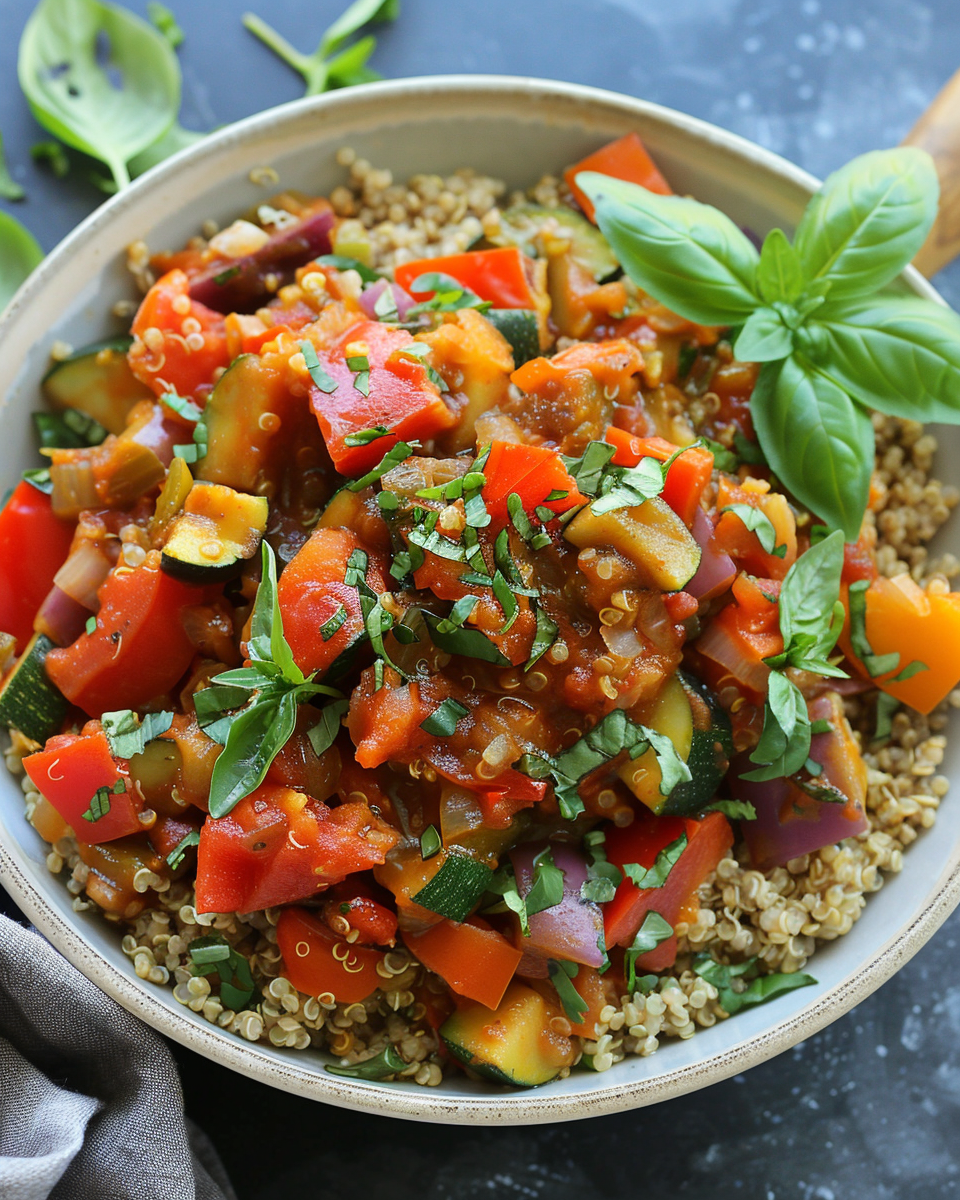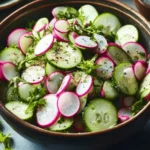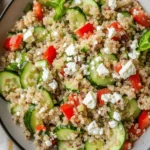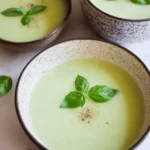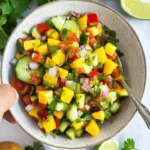A hearty and vibrant dish packed with fresh vegetables simmered slowly to perfection in a crockpot, this Garden Fresh Ratatouille Bowl is a comforting vegetarian meal that’s easy to prepare and full of Mediterranean flavors. It’s perfect for a wholesome dinner or meal prep and can be enjoyed on its own or paired with rice, quinoa, or crusty bread.
FULL RECIPE
Ingredients
- 1 medium eggplant, diced
- 2 medium zucchini, diced
- 1 red bell pepper, chopped
- 1 yellow bell pepper, chopped
- 1 onion, finely chopped
- 3 cloves garlic, minced
- 4 medium tomatoes, diced (or 1 can diced tomatoes, 14 oz)
- 1/4 cup olive oil
- 1 teaspoon dried thyme
- 1 teaspoon dried oregano
- 1/2 teaspoon dried basil
- 1/4 teaspoon crushed red pepper flakes (optional)
- Salt and pepper to taste
- Fresh basil leaves for garnish
- Cooked quinoa or rice, for serving (optional)
Directions
- Add the diced eggplant, zucchini, bell peppers, onion, and garlic to the crockpot.
- Stir in the diced tomatoes and olive oil until all ingredients are well combined.
- Sprinkle thyme, oregano, basil, red pepper flakes (if using), salt, and pepper over the vegetable mixture and stir gently.
- Cover the crockpot and cook on low for 6-8 hours or on high for 3-4 hours, until the vegetables are tender and flavors meld together.
- Taste and adjust seasoning if necessary.
- Serve hot, garnished with fresh basil leaves. Enjoy over cooked quinoa or rice for a complete meal.
Nutrition Facts
- Calories: 180 kcal
- Total Fat: 12 g
- Saturated Fat: 1.8 g
- Cholesterol: 0 mg
- Sodium: 150 mg
- Total Carbohydrates: 18 g
- Dietary Fiber: 6 g
- Sugars: 8 g
- Protein: 4 g
- Vitamin A: 25% DV
- Vitamin C: 70% DV
- Calcium: 6% DV
- Iron: 10% DV
The Origins of Ratatouille
Ratatouille is a traditional French Provençal stewed vegetable dish, originating from the region of Nice. It was originally a humble farmer’s meal designed to use fresh, seasonal vegetables abundant in the Mediterranean climate. Over time, ratatouille has gained international recognition, celebrated for its rustic charm and vibrant flavors. The dish typically features eggplant, zucchini, peppers, tomatoes, and herbs, showcasing the simple, wholesome ingredients that characterize Mediterranean cuisine.
The Nutritional Benefits of Ratatouille
Ratatouille is a nutritional powerhouse packed with vitamins, minerals, and fiber. The vegetables in this dish are low in calories but high in antioxidants and nutrients, such as vitamin C, vitamin A, potassium, and dietary fiber. These components support immune health, aid digestion, and contribute to overall well-being. Additionally, ratatouille is naturally gluten-free and vegan, making it accessible to a wide range of dietary needs.
Why Use a Crockpot for Ratatouille?
Using a crockpot to prepare ratatouille allows the flavors to meld slowly over several hours, creating a deep, harmonious taste that’s difficult to achieve with quicker cooking methods. The low and slow cooking process softens the vegetables perfectly while preserving their nutritional content. It also makes the dish incredibly convenient for busy individuals, as it requires minimal hands-on time and can be set to cook while you focus on other tasks.
The Role of Olive Oil in Ratatouille
Olive oil is a staple ingredient in Mediterranean cooking and plays a critical role in ratatouille. It adds richness and a subtle fruitiness that enhances the natural flavors of the vegetables. Moreover, olive oil is rich in monounsaturated fats, which have been linked to heart health benefits. Using good quality extra virgin olive oil elevates the dish’s taste and contributes to its health benefits.
Flavor Profile and Herb Selection
The combination of herbs such as thyme, oregano, and basil gives ratatouille its distinctive aromatic profile. These herbs complement the sweetness of the tomatoes and the earthiness of the eggplant and zucchini. The addition of crushed red pepper flakes adds a gentle kick of heat, but this can be adjusted to taste. Fresh basil at the end adds brightness and a fresh finish, highlighting the Mediterranean roots of the dish.
Versatility of Ratatouille in Meal Planning
Ratatouille is an incredibly versatile dish that can be served as a main course, side dish, or even a filling for wraps and sandwiches. It pairs well with grains like quinoa, rice, or couscous and can also be served alongside protein options like grilled chicken or fish. Its flexibility makes it a great choice for meal prep, as leftovers reheat beautifully and can be reinvented in different meals throughout the week.
Ratatouille and Plant-Based Eating Trends
With the rise of plant-based diets, ratatouille fits perfectly into contemporary eating habits. It offers a delicious way to enjoy a variety of vegetables in one dish, satisfying both taste and nutritional needs without relying on animal products. Its rich texture and complex flavors make it appealing even to those transitioning to vegetarian or vegan lifestyles, demonstrating how plant-based meals can be both nourishing and flavorful.
How to Adapt Ratatouille for Different Palates
Ratatouille can be easily adapted to suit different taste preferences and dietary restrictions. For those who prefer a spicier dish, additional chili flakes or smoked paprika can be added. If you want a creamier texture, stirring in a bit of coconut milk or a dollop of cashew cream can provide richness. For a heartier meal, adding beans or lentils increases protein and fiber, making the dish even more satisfying.
Seasonal Variations and Ingredient Substitutions
While traditional ratatouille uses specific vegetables, it’s highly adaptable based on seasonal availability. In the summer, fresh garden vegetables shine best, but in colder months, you can substitute with roasted winter squash, sweet potatoes, or even mushrooms for a different flavor and texture profile. This flexibility ensures that ratatouille can be enjoyed year-round with fresh, local produce.
The Importance of Texture in Ratatouille
Texture plays a key role in the enjoyment of ratatouille. The ideal dish balances tender, slightly softened vegetables with just enough bite to prevent it from becoming mushy. Slow cooking in a crockpot helps maintain this balance by gently breaking down the vegetables without turning them into a puree. Proper texture enhances the eating experience, making the dish satisfying and comforting.
Serving Suggestions and Pairings
Ratatouille can be served in numerous ways depending on the occasion. For a light lunch or dinner, serving it over cooked grains such as quinoa or brown rice makes for a nutritious, filling meal. It also pairs wonderfully with crusty artisan bread, perfect for soaking up the flavorful juices. For a more indulgent option, topping ratatouille with a poached egg or melted cheese adds richness and protein.
Cultural Significance and Popularity
Beyond being a beloved French dish, ratatouille has grown in global popularity partly thanks to media and culinary influences. It represents the essence of slow, mindful cooking and the beauty of simple ingredients treated with care. The dish has been celebrated in films, cookbooks, and restaurants, symbolizing both comfort and sophistication in vegetable cooking.
Conclusion
Garden Fresh Ratatouille made in a crockpot offers an effortless way to enjoy a classic Mediterranean dish that is both nutritious and bursting with flavor. Its roots in Provençal cooking highlight the beauty of fresh, seasonal vegetables and simple ingredients brought together with herbs and olive oil. This dish’s adaptability, health benefits, and ease of preparation make it a perfect addition to any meal rotation, especially for those embracing plant-based or health-conscious lifestyles. Whether served as a main course or a side, ratatouille invites you to savor the richness of fresh garden produce in every bite.

